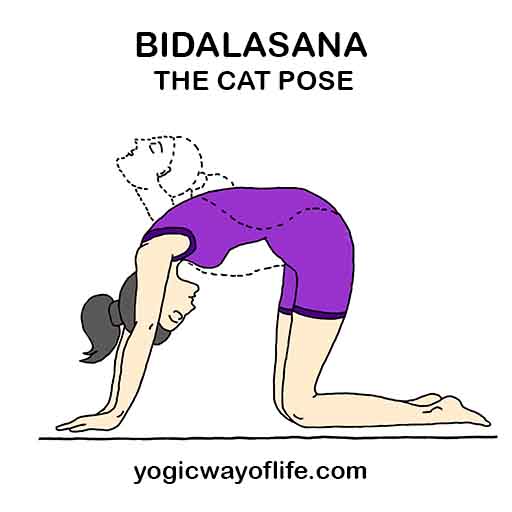The Cat Pose or Bidalasana in Yoga is excellent for improving flexibility of the spine. Most of the asanas or poses have been adopted by observing animals. In sanskrit, Bidala means the cat and Asana is a pose. Bidalasana is also known as Marjariasana. This posture helps to improve the flexibility of the back and the spinal column.

The steps to perform the Cat pose are as follows:
How to do Bidalasana (The Cat Pose)?
- Kneel on the floor and lean forward putting both your palms on the floor pointing forward.
- The legs can be slightly apart and palms should be at shoulder length.
- Let your trunk be parallel to the ground, the thighs should be vertical and straight. The lower leg and feet should be on the floor.
- This is the base position. Relax your body completely. Make sure your shoulder and back muscles are relaxed.
- Now exhale completely and feel your belly go inwards. At the same time move your head inwards between your shoulders. While doing this your head will bend forwards and the spine will arch downwards.
- Now inhale and arch your back in the opposite direction. Arch your head, neck and shoulders upwards and backwards; and look up . This is Bidalasana or the cat pose.
- Repeat this process, as many times as you are comfortable. Do this asana with slow and deep breathing and feel the stretch it gives to your back, neck and shoulders. Feel the stiffness disappear and the sense of greater flexibility in your back muscles and spine.
The benefits of Bidalasana as discussed next.
Benefits of Bidalasana (The Cat Pose)
- Bidalasana loosens up the spine and make it flexible. It gets rid of stiffness in the back muscles.
- It is good for those suffering from Spondylitis and slipped disk, especially with the backward bending which follows the forward bend.
- Bidalasana also has an indirect effect on the organs of the lower abdomen, including the digestive system, intestines and the reproductive organs. It gives a good massage and stretch to these organs.
Contraindications for Bidalasana (The Cat pose)
- Those who have undergone any recent surgery of neck or spine should avoid this pose.
- If you have pain in the knees while kneeling down, you may use a soft and steady cushion to support the knees.

Hari Om
Thank you for sharing this document. It is very usefull.
Regards
Arun kumar.R